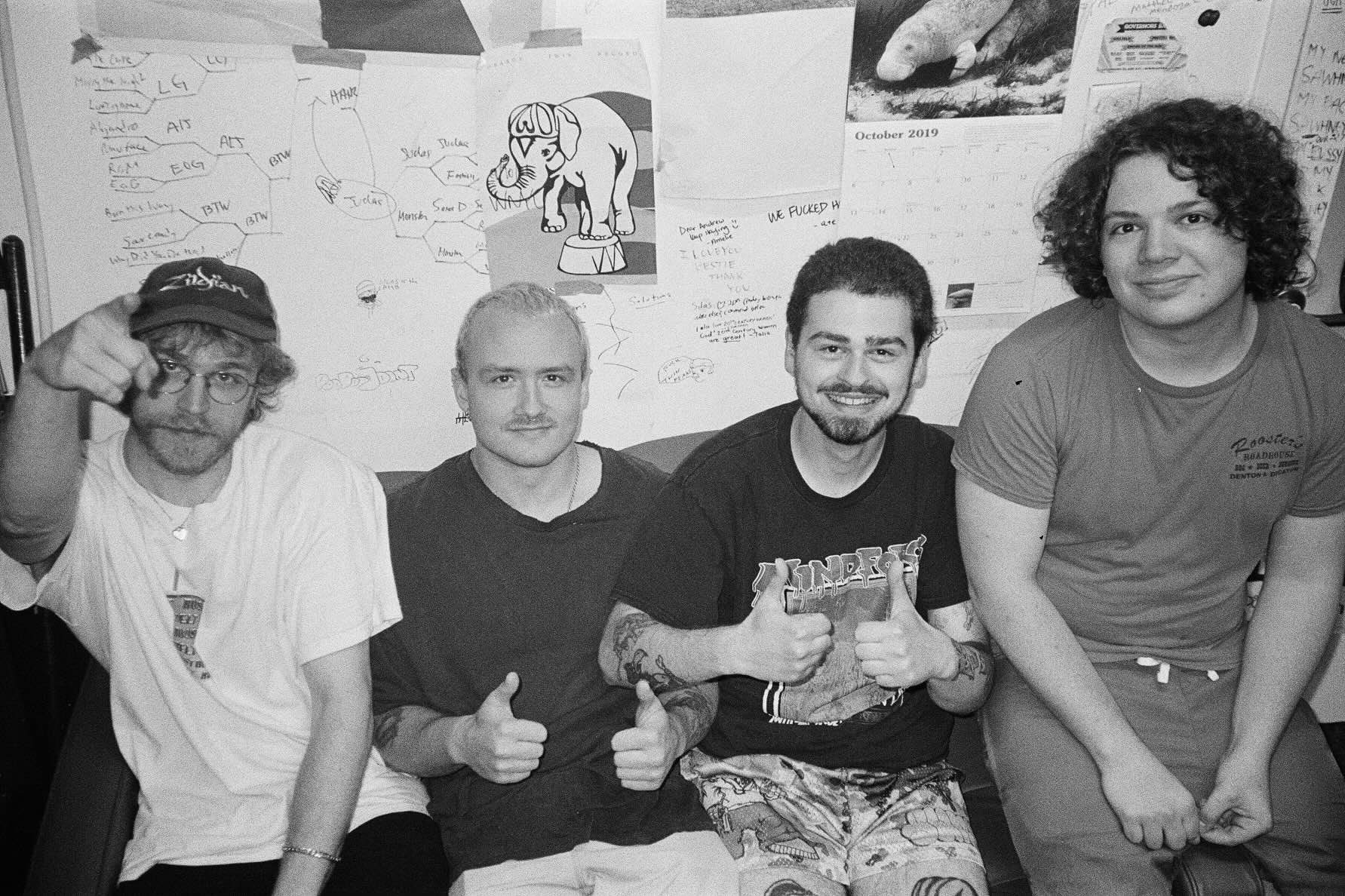“I know what I just told you, but can you actually make it louder?” Ilan Natter, one of the two drummers in Lip Critic, asked WNYU’s sound engineer Jamie Walker as the band prepared for a performance in the radio room’s recording booth.
“That’s usually not a request I ever get asked,” Walker admitted, adjusting the earplugs the band had reminded us to put in, “But yeah, I can make it louder.”
“No dynamics allowed,” frontman Bret Kaser joked before stepping back into the shoebox-sized recording room. Already a tight space to navigate, Lip Critic had spent two hours shoving two drum kits, a table, and a seemingly endless supply of wires and amps into the booth for their set. The foursome- consisting of members Kaser, Natter, drummer Danny Eberle and sampler Connor Kleitz -was no stranger to the tight recording spaces of a university practice room, having formed Lip Critic in 2018 while attending Purchase College in Harrison, New York.
“Connor and I love electronic music, we definitely grew up making electronic music. But the one thing that you never get across with it [DJing] is a really intense, engrossing live show a lot of the time; that’s where it falls short,” said Kaser, “We wanted to find a way to incorporate all these things we love about the live aspect of hardcore music, and metal, and punk but have all the stuff we love about producing techno and industrial music. Ilan and Danny have known each other forever. Connor and I were both looking for a project where we could do this club music-fusion thing, and they were both looking for the same thing. It kind of just happened that we were in the right place at the right time.”
Lip Critic’s jittery cacophony of noise had rapidly grown in popularity following the May release of their debut album, Hex Dealer–an album so unique that even the band had a hard time explaining it. “Album,” Kaser responded when asked to describe their debut in one word, “codified.”
“Abrasive,” Kleitz added, “Loud.”
“Relentless. In the sense that there is no breath, really,” Natter chimed in.
“I think [it’s] chaotic. That shit is like 30 minutes long, and all 30 minutes, you’re getting slapped in the face,” Eberle described.
Taking inspiration from the 1992 film “Leap of Faith” starring Steve Martin, the album loosely follows a corrupt preacher who is brought to life on both the album and the stage by Bret Kaser’s enticingly strange and unpredictable vocal inflections. “I really liked comedy before- and at the same time -as music. I like watching a ton of stand-up and a ton of sketch stuff so I feel like there’s almost an element of that. I’m always trying to be like a character in a sketch who is not the straight man, you know? It’s like the character that everyone else is looking at and being like, ‘This guy’s off base,’” Kaser elaborated.
However, Kaser’s character is nothing without the extremities brought to life by his production and the other members’ instrumentals. Drawing inspiration from off-the-wall acts like Soul Coughing, Gulch, Television and Full of Hell, Lip Critic melds abrasiveness with weirdness to create something entirely different, according to Eberle.
“We’re just coming up with individual parts that sound like Lip Critic songs. We’re trying not to make them sound like anything else,” Eberle said. The coarse nature of their sound is brought to a new dimension by the samples collected and utilized by Kleitz.
“A lot of the stuff we’re playing live is just reworking in the stuff that we use in the records, and then the stuff that you find on the records is a lot of found sounds from environmental space,” Kleitz said, “ I think of the power station we sampled in Austin, Texas because it sounded like a god chord. Or we found a pole in the venue in Ottawa that we’re just slamming a table against because it sounded really cool. And then we ended up sampling a lot of a capella vocals from pop music. It’s just kind of the music that I like to listen to, and I end up resampling it a lot of the time just because I like it.”
With an intense emphasis on drumming, Lip Critic brings an extraordinary sound that makes them stand apart from their aforementioned inspirations. Having two drummers is a challenge within itself, but an exciting one that the band is happy to undertake. “It’s a lot of stuff to carry,” Natter joked when asked about the challenges of balancing two drummers.
“It makes everything a little more difficult. You have to bring two drum kits and all this stuff into the venue. And then setup for two drum kits, tests mics for drum kits, but it makes it really fun. It’s really fun, two drums. It’s different,” Eberle elaborated, “In Lip Critic, we’re trying to blend the drums. I always say in every interview- it’s cliché at this point -but I just think of the record ‘Marquee Moon’ by Television, where there are two guitars on the record, but they’re not doing the same thing. But there’s no distinction between lead guitar and rhythm guitar; there’s rarely even soloing on the record. I kind of want to take that certain approach with the drums in Lip Critic where it’s like, not one drum’s a rhythm drummer, and one is doing lead or more fills and shit. I want there to be a balance.”
“It’s a challenge. But it’s a fun challenge,” Eberle stated as the following members agreed.
Fun is exactly what Lip Critic brings to their live performances. Shoved inside a recording room no bigger than a closet, it’s clear to just how much fun the band is having with their sound, and with each other. Their insane live performances have only helped propel the band into becoming cult classics within the experimental scene. Coming off the heels of a seven-week tour spanning the United States and the United Kingdom, Lip Critic’s NYC appearances were the first time the group had played a hometown show since the album release. The band recounted tour memories from the past two months of places they’d never been to before. “I really liked the show in Ottawa we played,” Kaser told me, “It was tacked on kinda last minute, and we didn’t really know if anyone was gonna pull up– this entire tour, we did not know if anyone was gonna show up. It ended up being a good show, but also the people that pulled up were just there to see what was going on. It was a cool moment to have people wandering in and just trying to find music, see the show, and then like it. It was very interesting.”
“Boston, too,” Eberle chimed in, “I thought it was an insane crowd. Really, really violent, aggressive crowd. But everyone looked like they were having a good time; nobody looked like they were pissing another person off. No one looked like they were overtly hurting anybody or anything like that; it was just like everyone was there to go crazy. It was kind of a scrappy show- like the venue itself -we didn’t have a soundcheck, tiny ass room. But I think that kind of just added to how primal and heavy and crazy that show was.”

